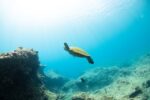
Green Sea turtles travel about 902 km; 560 mi from The French Frigate Shoals to Lanikea beach, North Shore of Oahu.
Every year, many green sea turtles make the 1,200-mile (1,931-kilometer) round-trip migration from foraging habitats in the main Hawaiian Islands to reproduce and nest at French Frigate Shoals in the Northwestern Hawaiian Islands and then swim back again.
[NOAA, 2021]

Since 1973, biologists with PIFSC’s Marine Turtle Biology and Assessment Program have also made the annual trip to remote French Frigate Shoals to monitor nesting activity.
[NOAA, 2021]

Between mid-March and mid-May, Laniakea honu begin their nesting migration to the Northwest Hawaiian Islands. Most honu (or honu as they are locally known in Hawai‘i)have preferred East Island of the French Frigate Shoals in the past but Hurricane Walaka virtually destroyed the island in October 2018. Honu are very resilient and will adapt to the changed situation but it is yet to be determined where the majority of the individuals now displaced from their normal nesting island will choose to establish their nests in the future.
[Malama na Honu, 2021]
What are Green Sea Turtles eating?
They are herbivores, eating mostly seagrasses and algae (lime as they are locally known in Hawai‘i) growing underwater on coral reefs and rocks in shallow waters. Algae or seaweed is a popular sea plant included in various Hawaiian dishes. Limu is usually served as healthy vegetables mixed in salads, poke, and stews.

Where is French Frigate Shoals?
The French Frigate Shoals are about 487 nautical miles (902 km; 560 mi) northwest of Honolulu. French Frigate Shoals is an open atoll consisting of a large, crescent-shaped reef surrounding numerous small, sandy islets. While the land area is only 1⁄4 square kilometer (67 acres), the total coral reef area of the shoals is over 938 square kilometers (232,000 acres).

French Frigate Shoals has one of the most significant reef systems in the Northwestern Hawaiian Islands. The reef supports the greatest variety of coral species including the acropora table coral, finger coral, and stony coral. There are also over 600 species of invertebrates such as sponges, coral worms, snails, lobster, crabs, shrimp clams, oysters, sea urchins, and sea stars. Many of these invertebrates are endemic (found only there) to the shoals. There are over 150 species of algae living among the reefs. They include red, green and brown algae. Other marine life are the large invertebrates such as echinoderms, crustaceans, and mollusks. One area of the reef consists almost entirely of bivalve clams. The outer reef waters support gray reef sharks, butterfly fish, and large schools of jacks and groupers.
[U.S. Fish & Wildlife Service, 2021]

French Frigate Shoals nutures plenty of charismatic megafauna — the green turtles and Hawaiian monk seals. Over 90% of the Hawaiian population of threatened green turtles travel to the FFS for safe nesting. Satellite tagging of these turtles has indicated that most of them migrate to the main Hawaiian Islands to feed and then return to breed at French Frigate Shoals, while some turtles travel northwest to feed and others have traveled as far south as Johnston Atoll. The many small islets of FFS also attract the largest number of endangered Hawaiian monk seals in the NWHI. It is “their” place of refuge.
[U.S. Fish & Wildlife Service, 2021]
References
Ellis, G. H. (2021, OCT 21). SATELLITE TELEMETRY OF MIGRANT MALE AND FEMALE GREEN TURTLES BREEDING IN THE HAWAIIAN ISLANDS. Retrieved from www.turtles.org: http://www.turtles.org/ffs/migrate/ffsmigrt.htm
Malama na Honu. (2021, Oct 24). Turtles in the Hawaiian Islands. Retrieved from Information: https://malamanahonu.org/information/
NOAA. (2021, Oct 10/24). By the Numbers: The Annual Migration of Green Sea Turtles in Hawaiʻi. Retrieved from NATIONAL OCEANIC AND ATMOSPHERIC ADMINISTRATION (NOAA): https://www.fisheries.noaa.gov/feature-story/numbers-annual-migration-green-sea-turtles-hawaii
U.S. Fish & Wildlife Service. (2021, OCT 21). French Frigate Shoals. Retrieved from Hawaiian Islands: https://www.fws.gov/refuge/Hawaiian_Islands/about/French_Frigate_Shoals.html



